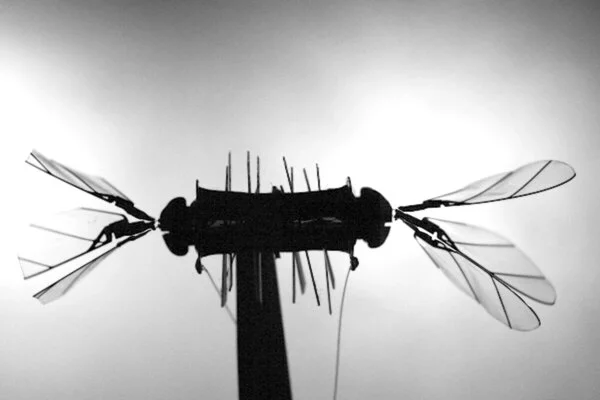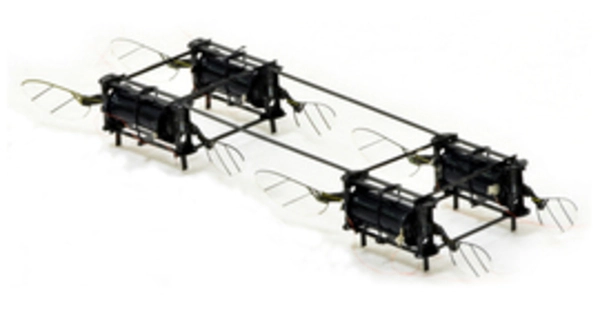Researchers have created resilient artificial muscles that can help insect-scale aerial robots recover flight performance after severe damage. Bumblebees have clumsy flight abilities. A foraging bee is estimated to collide with a flower once every second, causing damage to its wings over time. Bumblebees can fly despite having many tiny rips or holes in their wings.
Aerial robots, on the other hand, are not as tough. Poke holes in the robot’s wing motors or cut off a section of its propellor, and it will almost certainly be grounded. Inspired by the toughness of bumblebees, MIT researchers developed repair techniques that allow a bug-sized aerial robot to sustain severe damage to the actuators, or artificial muscles, that power its wings while still flying effectively.
They optimized these artificial muscles so that the robot can better isolate defects and overcome minor damage, such as tiny holes in the actuator. Furthermore, they demonstrated a novel laser repair method that can assist the robot in recovering from severe damage, such as a fire that scorches the device.
Using their methods, a damaged robot could maintain flight-level performance after one of its artificial muscles was jabbed with ten needles, and the actuator could still function after a large hole was burned into it. Their repair methods allowed a robot to continue flying even after the researchers severed 20% of its wing tip. This could improve the ability of swarms of tiny robots to perform tasks in difficult environments, such as conducting a search mission through a collapsing building or dense forest.
In a way, we are trying to do surgery on muscles. But if we don’t use enough power, then we can’t do enough damage to isolate the defect. On the other hand, if we use too much power, the laser will cause severe damage to the actuator that won’t be clearable.
MIT researchers
Robot repair techniques
The tiny, rectangular robots being developed in Chen’s lab are roughly the size and shape of a microcassette tape, though one robot weighs only a paper clip. Dielectric elastomer actuators (DEAs), which are soft artificial muscles that use mechanical forces to rapidly flap the wings, power the wings on each corner. Layers of elastomer are sandwiched between two razor-thin electrodes and rolled into a squishy tube to create these artificial muscles. When you apply voltage to the DEA, the electrodes squeeze the elastomer, which causes the wing to flap.
But microscopic imperfections can cause sparks that burn the elastomer and cause the device to fail. About 15 years ago, researchers found they could prevent DEA failures from one tiny defect using a physical phenomenon known as self-clearing. In this process, applying high voltage to the DEA disconnects the local electrode around a small defect, isolating that failure from the rest of the electrode so the artificial muscle still works.

This self-clearing process was used by Chen and his colleagues in their robot repair techniques. First, they optimized the concentration of carbon nanotubes in the DEA’s electrodes. Carbon nanotubes are extremely strong but very small rolls of carbon. Because it reaches higher temperatures and burns away more easily when there are fewer carbon nanotubes in the electrode, it improves self-clearing. This, however, reduces the power density of the actuator.
“You will run out of energy at some point, but we need a lot of energy and power to fly the robot. We had to find the sweet spot between these two constraints: optimize the self-clearing property while keeping the robot flying in mind” Chen claims.
However, even an optimized DEA will fail if it suffers from severe damage, like a large hole that lets too much air into the device.
Chen and his team used a laser to overcome major defects. They carefully cut along the outer contours of a large defect with a laser, which causes minor damage around the perimeter. Then, they can use self-clearing to burn off the slightly damaged electrode, isolating the larger defect.
“In a way, we are trying to do surgery on muscles. But if we don’t use enough power, then we can’t do enough damage to isolate the defect. On the other hand, if we use too much power, the laser will cause severe damage to the actuator that won’t be clearable,” Chen says.
Flight test success
After perfecting their techniques, the researchers ran tests on damaged actuators, some of which had been jabbed with many needles and others had holes burned into them. They evaluated the robot’s performance in the flapping wing, take-off, and hovering experiments.
Even with damaged DEAs, the repair techniques allowed the robot to maintain flight performance, with altitude, position, and attitude errors that were only slightly different from an undamaged robot. A DEA that would have been irreparably damaged was able to recover 87 percent of its performance thanks to laser surgery.
“I have to give credit to my two students, who worked extremely hard while flying the robot. Flying the robot by itself is difficult, especially now that we are intentionally damaging it” Chen states.
Because these repair techniques make the tiny robots much more durable, Chen and his team are now working on teaching them new skills, such as landing on flowers or flying in a swarm. They’re also working on new control algorithms to help the robots fly better, teaching the robots to control their yaw angle so they can maintain a constant heading, and allowing the robots to carry a tiny circuit, with the long-term goal of carrying its own power source.





